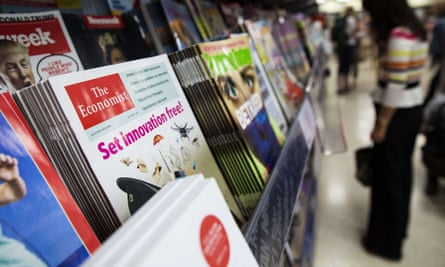Set aside this summer’s No 10 pulsations for a while and look at the noisy press gang on the other side of Downing Street. In particular, note how two heavyweight reports – one British, one American – have just sung the same grim song about newspaper futures.
The first, from the Pew Research Center in Washington DC, sees 2015 as possibly “the worst year for newspapers since the Great Recession” and its immediate aftermath: “Daily US circulation fell by 7%, the most since 2010, while advertising revenue at publicly traded newspaper companies fell by 8%.”
OK, but surely digital advertising was supposed to be the industry’s salvation? Alas, “almost two-thirds of $60bn in digital advertising spending (65%) went to just five technology companies: Google, Facebook, Yahoo, Microsoft and Twitter. Despite this, legacy news gets relatively little boost from this digital boom … While 25% of publicly held newspapers’ ad revenue is from digital, they actually saw overall digital ad revenue fall by 2% in 2015.”
And – second out of the traps – the Reuters Institute finds exactly the same crunch in Britain and around the rest of the globe: digital ads draining away, growth hopes stalled, branding and the importance of running your own website diminishing as Facebook and Google mop up the stories they like. Plus the fact that “most consumers are still reluctant to pay for general news online, particularly in the highly competitive English-speaking world (9% average). But in some smaller countries, protected by language, people are twice as likely to pay.”
Is France a “smaller country”? Louis Dreyfus, the publisher of Le Monde, out on the international conference circuit, tells a rather bigger story. Five years ago, France’s most famous paper was losing money fast and seemingly lurching towards the grave. But then – after something of a confrontation with editorial staffers who thought they were in charge – the paper’s commercial owners implemented a new strategy you might call “everything but the kitchen sink”.
“At Le Monde, we believe print is not dead,” says Dreyfus. “Whatever the difficulties or losses are, people will buy our product, whether that is in print or digital, as long as we have exclusive content. We will survive and grow if we have the best journalists, and that is the first priority for us.” A priority pursued with formidable energy and controlled momentum.
Here’s a new, glossy magazine, then. Here’s a determined push into reporting finance, with a special business section added. Here’s a shrewdly judged paywall (€19 a month for all print and digital content seven days a week) with new specialist digital sites like Le Monde Afrique. Here – at long, long last – is a morning edition of Le Monde. Here are festivals and training schools for readers, a new spirit of engagement.
In short, it’s change and innovation on every front. Of course, many of those ideas are familiar, pursued by other papers round the world. But the total package, not choosing between initiatives, exploring all avenues in French, brings particular force to bear and seems to be bringing particular success away from the English-speaking opportunity-cum-blight of the big US battalions. Aux armes, citoyens …

But do not, perhaps, treat language alone as the underpinning of renewed success in Paris. Think of it more as a definition of distinctiveness, one vital point of difference. For other newsrooms that offer something different have also had good news to trumpet on their home front in the past few weeks. There’s the Economist, with its annual accounts showing pre-tax profits up from £59.3m to £60.6m and turnover up from £324m to £331m. Maybe print advertising has slumped and slumped again, down to £41m in the year to March. But print and digital circulation profits have risen 31%, with overall sales rising 3.5% year on year – and takers of initial cut-price offers trading up to more lucrative premium packages.
Tom Standage, the deputy editor, makes a vital point. “We now have a team of 10 writers and editors promoting our output on a growing range of social platforms. We have over 17 million followers on Twitter and 7.7 million on Facebook … Our posts on social platforms encourage new readers to sample our journalism.
“But our aim is always to drive them towards our own website and apps, where we can encourage them to become subscribers. We give away a limited number of articles on distributed platforms as part of this strategy, but access to the full breadth of our output still requires a subscription, and always will.”
In short, you can lessen the impact of ad blockers and malign algorithms and take control of social media if you put most of your emphasis on digital and print sales. And also if, Economist readers might add, the print version still helps define a brand image that can’t get blown away or submerged whenever Facebook fiddles with its algorithms.
Print is part of the Le Monde equation, part of the Economist profits plan – and, interestingly, one aspect of Johnston Press’s early success with the i newspaper it bought six months ago from the Independent – with sales now nudging 300,000 and growing as the roundabouts of political life turn faster.
Katharine Viner, the editor of the Guardian, posed the dilemma that troubles so many newsrooms in a notable essay. “While the possibilities for journalism have been strengthened by the digital developments of the last few years, the business model is under grave threat, because no matter how many clicks you get, it will never be enough. And if you charge readers to access your journalism you have a big challenge to persuade the digital consumer who is used to getting information for free to part with their cash.”
That dilemma, of course, is particularly acute on the Guardian, reporting an operating loss of nearly £69m in the year to March in an era when advertising sales find it particularly hard to take the strain. (Digital ad returns down £2m year-on-year; print ads taking a 15% cold bath.) But, right across the newspaper world, the challenges are much the same. The New York Times has just posted a $500,000 loss in the second quarter, with print ads down 14% and digital advertising, supposed salvation, down 7%.
That difficult, archetypal equation – prompting a wide range of different possible answers, from paywalls to crowdfunding, from expansion to retrenchment – is a common challenge. The question is not merely can print newspapers survive, but can the general newsroom that covers news and views across the piste find any secure footing in an environment where the social media giants call every shot, making transition to any independent future a distant dream?
You’d say, as the evidence comes in, that news or comment which targets particular audiences and keeps the clear branding of print in the mix has some opportunities to survive and prosper. You’d add that the last 15 years have been stuffed with false starts and changes of tack. But you’d also add that general gloom is a lousy counsellor. It’s only a handful of weeks since the news – including that news from Downing Street – saw print sales and online views boom away: a first recourse in times of need. Readers still respond mightily to mighty events. Formez vos bataillons. Marchons, marchons!

